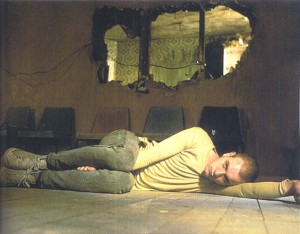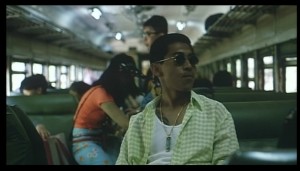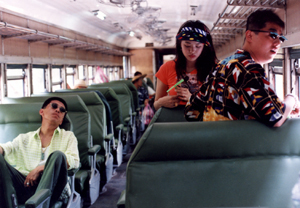Adapted and condensed from “Comparaisons à Cannes,” translated by Jean-Luc Mengus, Trafic no. 19, été 1996. -– J.R.
In his introduction to Understanding Media, Marshall McLuhan
records the consternation of one of his editors that “seventy-five
per cent of your material is new. A successful book cannot venture
to be more than ten per cent new.” From the vantage point of this year’s
Cannes Festival, a compulsion to contextualize everything new in
relation to something familiar reveals a comparable problem. Indeed, the
kind of movie pitch parodied at the beginning of Altman’s The Player,
in which every project becomes some version of one or two previous
hits — “The Graduate, Part 2,” “The Manchurian Candidate meets
Ghost” — has by now become a kind of journalistic shorthand for the
critic eager to make the film fully accessible once it’s released. This
necessity of establishing old references in relation to new ideas is above
all an indication of how thoroughly the priorities of the film business
have infiltrated film criticism.
As useful as this practice is, it often functions as a kind of nervous
tic. For the writer or speaker too lazy to perform the less alluring task
of description, it poses a constant temptation — a means of short-
circuiting the critical process through a kind of magic or alchemy that
suddenly makes the invisible visible. Being more guilty of this habit
than most, and finding it especially hard to avoid during the daily
pressures of Cannes, I’d like to attempt both a critique and an
autocritique of this tendency, hopefully indicating when it can serve
a useful critical function and when it simply interferes with critical
analysis.
To begin with an example that strikes me as being especially
dubious — a form of comparison that seems indistinguishable from
advertising — consider the following sentence from Janet Maslin in one of
her Cannes reports: “Set in Edinburgh (and already a big hit in
England), Danny Boyle’s Trainspotting is sure to prompt controversy as a
hip, clever provocation that’s raw enough to make Kids look like
Sesame Street.”
In point of fact, when Maslin calls Trainspotting “raw” she isn’t
referring to the film’s style, which holds relatively little interest for her,
but to her sense of the content, such as male frontal nudity and
excrement: “Tauntingly decadent, Trainspotting lets its drug-addicted
characters show off violent and grossly scatological behavior that will send
some viewers racing for the exits.” Stylistically, the film is actually
much less “raw” than the pseudo-documentary manner of Kids; it’s an
imaginative stylistic exercise that for me — to play my own version of the
comparison game — evokes Richard Lester in the early sixties in terms
of visual play and Kubrick’s A Clockwork Orange in terms of narrative
form. In fact, these references occur to Maslin as well, but she couches
them again mainly in terms of puritanical class content: “Yet this
willfully outrageous film also has no trouble evoking either a grungier
Clockwork Orange or a ruder set of Beatles.” The Beatles are of course
the “product” being sold in A Hard Day’s Night and Help!; Lester is
only the film artist involved.
One reason for focusing on Maslin is that, thanks to her position,
she is the writer who has the most effect on which foreign films will
open in the United States and whether or not they will succeed
commercially. Yet the fact that she is clearly more interested in cinema as
a business than as an art, more fascinated by Harvey Weinstein than by
Kiarostami, Hou, or Godard, apparently places her in the majority —
which is why the circulations of the French and American Première
are higher than those of Cahiers du Cinéma, Positif, Trafic, Sight and
Sound, and Film Comment combined.
On the other hand, ten years ago, Première didn’t exist and Vincent
Canby, Maslin’s predecessor on The New York Times, was more
interested in art than in business. Did Première and Maslin suddenly come
along to “fill a need,” or did they, like so many of the movies they both
publicize, first manufacture the desire they now seek to exploit?
***
For me the principal pleasure afforded by Cannes is the
opportunity to take a two-week holiday from the so-called “fun” of
commercial American cinema, which tends to dominate the remainder
of my year. Perhaps this “fun” would feel less oppressive if it didn’t already
inform the experience in the United States of news, politics, fast food,
sports, economics, education, religion, and leisure in general, making it
less an escape than the very (enforced) essence of American life. A
bemusing paradox: after the alleged triumph of capitalism over Communism,
we find ourselves living in a “planned” culture that evokes in some
ways the Stalinism of the fifties, with Disney now assuming the
paternal role of the federal government, the spirit of Uncle Walt
supplanting the spirit of Uncle Joe. Within such a climate, the ideological
conformity of the press can seem no less claustrophobic, especially when
it comes to cultural references: during the last Christmas season, for
instance, I must have spent hours searching in vain for a single
American review of Oliver Stone’s overblown Nixon that failed to use the
adjective “Shakespearean.” The desire to dignify (and therefore sell)
political corruption with the nobility of classical culture seemed far
more important in this transaction than any desire to understand
Stone’s dramaturgy, and I would doubt that this impulse could be
plausibly linked to Luc Moullet’s effort in Cahiers du Cinéma in the fifties
to link Samuel Fuller to Christopher Marlowe.
In any case, one reason why Cannes offers an alternative to my
usual work is that most of the films shown here won’t open in Chicago
for another year. This is even true for certain American films if these
films are deemed “difficult” for the American public (which often
means politically threatening): last year’s Dead Man, for instance,
which has already had commercial runs in Melbourne, Lisbon, and
Istanbul, won’t reach Chicago until late June 1996. This means that I’ll
have plenty of time to test and reflect on my first reactions to most films
before I write about them at any length. (Perhaps only a few months for
those like Trainspotting and The Eighth Day that already have the
smell of money and hence Maslin’s interest; most likely more than a
year for films like Mohsen Makhmalbaf’s Gabbeh and Hou Hsiao-
hsien’s Goodbye South, Goodbye that can be safely expected to have
neither.)
By now, I’ve developed such an automatic reflex of finding or
generating one cultural comparison per film at Cannes that I suspect it’s a
habit related to seeing several films per day, a convenient filing system.
In the case of Mike Leigh’s Secrets and Lies, the word “Ibsen” allows
me to organize certain observations I have about the film’s dramaturgy
and themes. But after I come out of Hou’s Goodbye South, Goodbye
with a certain sense of bewilderment — not knowing how to
contextualize this contemporary crime film in relation to Hou’s preceding
trilogy about the history of twentieth-century Taiwan — I feel that one
word from Marco Müller, director of the Locarno Film Festival, places
me on the right track: “Mahagonny.” Although I’ve never seen or read
Brecht’s opera, a constellation of elements in Hou’s film — elements
connected to the treatment of capitalism, the handling of music, the
episodic narrative, and even Hou’s exquisite sense of camera
placement — suddenly slide into focus. This comparison, however, may be
more useful to an occidental spectator like myself than to someone
from Taiwan. (By the same token, when I compare Râúl Ruiz’s
delightful Three Lives and Only One Death to late Buñuel — with Pascal
Bonitzer, Ruiz’s cowriter and “French connection” serving as the
counterpart to Jean-Claude Carrière — I conveniently ignore the fact that
Ruiz himself prefers Buñuel’s Mexican films.) Such a distinction may
be less relevant when considering the very beautiful Gabbeh in
relation to Paradjanov’s The Color of Pomegranates, if only because it
appears that Makhmalbaf thought of this relationship long before I did.
One might argue, of course, that with these two films, the style is also
shaped by the subject matter — the poet Sayat Nova in the case of
Paradjanov, the nomadic tribes in southwestern Iran who specialize in
weaving gabbehs in the case of Makhmalbaf. But it is still fascinating
to discover that Gabbeh started out as a documentary and evolved into
a fiction film only gradually, because that appears to have been what
happened to Paradjanov’s film as well — suggesting that what
Makhmalbaf learned from Paradjanov was not only an attitude toward
space and color, but also an attitude toward subject matter.







